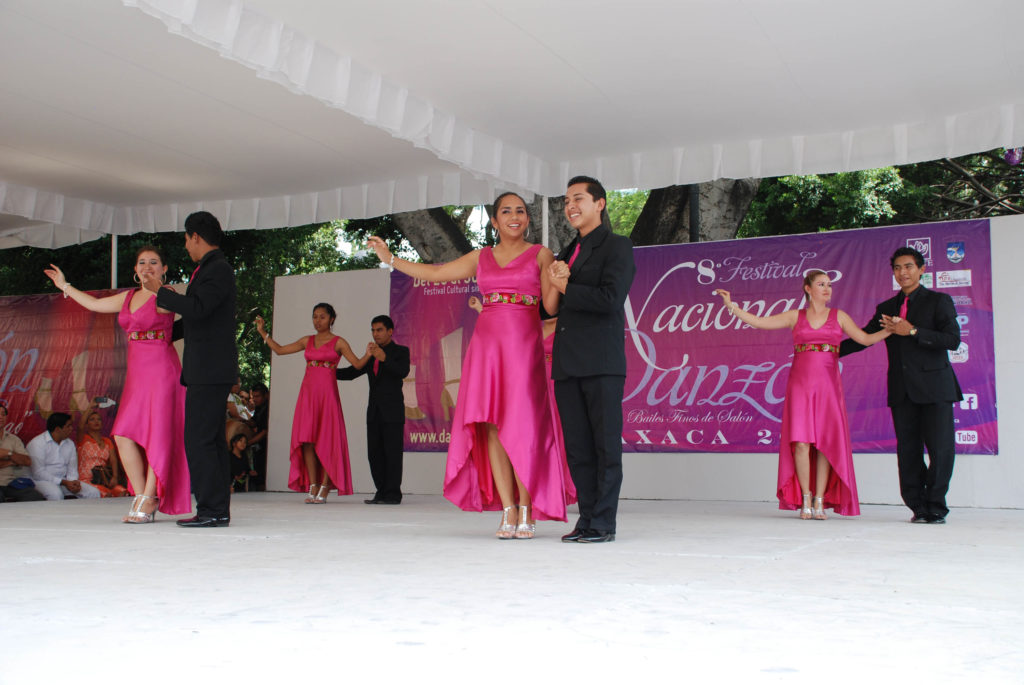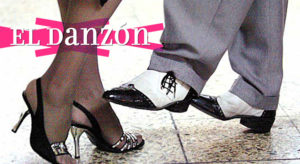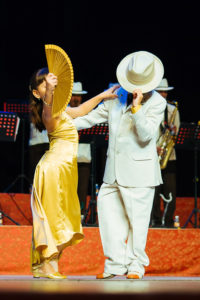THE “DANZÓN” WAS BORN IN CUBA AND WENT TO MEXICO TO STAY. VIDEO.
It was the month of December 1884 in the Mexican ‘Lonja de Merida’ which pleased the attendants with great interpretations of the Cuban danzones of the master Arturo Cosgaya along with those of Cuevas.
Mestizos and natives alternated with the elaborate ladies of contained meats in the tight corset, silks, olanes, lace, velvets and ribbons of their syrupy dresses, which they finished at the back with a large bow or stool, a garment known in Yucatan as ” Follow me, chicken “and in Cuba as” bullaranga “according to historians. The gentlemen, who were not left behind, with a sober elegance, drapery, vests, trousers and dark jackets, filled with false or true preseas and decorations, danced danzón, or so they thought, because they could never interpret it freely.
From the beginning of the year 1879 in Matanzas, Cuba, the musician Miguel de Failde Pérez had composed the then elegant and moved rhythm that the ships from Havana such as “Apollo”, “Yucatan”, “Coahuila” and “Cuba” By the coasts of the Gulf of Mexico with the cadence of this delicious and innovative rhythm. At first it had a European and aristocratic air and the same upper classes in Yucatan also danced but separated from the pair, with flower arches, similar to the contradanza, inherited from the first rhythms carried by the French who fled Haiti when the revolution In that country.
To the ballrooms, cinematograph dancing, brothels and cabarets, the danzón exploded musically between the years 1910 and 1920 approximately, a little demure, serious and exempt of the taste that gave the first Mexican dancers to him; Who the time was printing life, liturgy, form and diversity, reintegrating it to its original character somewhat lascivious and erotic. Similar appropriation that had been applied by the mulatto musicians of Cuba in their different stages.
Orchestras of authentic Cuban flavor coexisted with the enthusiasm of the genre then that was also accompanied sometimes with other genres and styles as was the son, the rumba and the Cuban guaracha. The old men tell that during the carnivals of Cuba the nights of “guateque” were armed and the island was heard the rumor of the panchanga to Puerto Progreso; You could hear the rumbón and danzoneo and you could see the glow of the artificial lights. During the 20’s in Progreso the celebrations were celebrated to the Cuban, the difference was that in the island the black population impressed the flavor, the rhythm and the joy.
Among the many groupings of then were the orchestra Esmeralda, of the teacher Julian Molina; That of Alfonso Baqueiro, the excellent danzonera of maestro Rubén Darío Herrera and the very popular danzonera Carta Clara, as well as those of Daniel Ayala Pérez, Pedro Hoil Calderón and those of Juan Concha.
It was definitely in Mexico where the Danzón resided; This musical genre of Cuban origin, was in Mexico where it was welcomed as a way to appreciate music in a special way, to the point that the legendary “SALÓN MÉXICO”, an almost centennial establishment that was baptized in its day as’ the cathedral Of the danzón ‘, dedicated almost exclusively to present / display to the danzón for more than fifty years without interruption.
The danzón is not a work of a race, a town or a continent since the groups and individuals through the process of localization have appropriated this dance, resignifying it as part of the “dance tradition” of the country.
The danzón, born in Cuba, but from its diffusion in the riparian areas of the Gulf of Mexico and the Caribbean would become a multinational rhythm that today continues to motivate the emotion and sensibility of musicians and dancers around the world.
EL DANZÓN NACIÓ EN CUBA Y FUE A MÉXICO PARA QUEDARSE. VIDEO.
Corria el mes de Diciembre de 1884 en la mexicana ‘Lonja de Merida’ que complacía con gran gusto a los asistentes con candentes interpretaciones de los danzones cubanos del maestro Arturo Cosgaya junto con los de Cuevas.
Mestizos e indígenas alternaban con las emperifolladas damas de contenidas carnes en el apretado corsé, las sedas, olanes, encajes, terciopelos y listones de sus almibarados vestidos, que remataban en la parte trasera con un gran moño o polizón, prenda conocida en Yucatán como “sígueme, pollo” y en Cuba como “bullaranga” según los historiadores. Los señores, que no se quedaban atrás, con sobria elegancia un tanto draculesca, chalecos, pantalones y jaquets obscuros atiborrados de preseas y condecoraciones ficticias o verdaderas, bailaban danzón, o por lo menos eso pensaron, pues nunca pudieron interpretarlo libremente.
Desde principio del año 1879 en Matanzas, Cuba el musico Miguel de Failde Pérez habia compuesto el entonces elegante y movido ritmo que los barcos procedentes de la Habana como el “Apolo”, “Yucatan”, “Coahuila” y el “Cuba” fueron regando por las costas del Golfo de México con la cadencia de ese delicioso e innovador ritmo. Al comienzo tenía un aire europeo y aristocrático y las mismas clases altas en Yucatan tambien lo danzaba pero separado de la pareja, con arcos de flores, semejante a la contradanza, heredada de los primeros ritmos llevados por los franceses que huyeron de Haiti cuando la revolución en aquel país.
A los salones de baile, dancing de cinematógrafo, prostíbulos y cabarets, el danzón explotó musicalmente entre los años 1910 y 1920 aproximadamente, un tanto recatado, serio y exento del gusto que le dieron primeros bailadores mexicanos; quienes el tiempo le fueron imprimiendo vida, liturgia, forma y diversidad, reintegrándolo a su original carácter un tanto lascivo y erótico. Similar apropiación que en sus diferentes etapas le habian aplicado los músicos mulatos de Cuba.
Orquestas de auténtico sabor cubano convivieron con el entusiasmo de el genero entonces que tambien era acompañado a veces con otros géneros y estilos como era el son, la rumba y la guaracha cubana. Narran los viejos que durante los carnavales de Cuba se armaban las noches de “guateque” y de la isla se escuchaba el rumor de la panchanga hasta Puerto Progreso; se escuchaba el rumbón y el danzoneo y se podía observar el resplandor de las luces artificiales. Durante los años 20’s en Progreso las fiestas se celebraran a lo cubano, la diferencia era que en la isla la poblacion negra imprimia el sabor, el ritmo y la alegría.
Entre las muchas agrupaciones de entonces estaban la orquesta Esmeralda, del maestro Julián Molina; la de Alfonso Baqueiro, la excelente danzonera del maestro Rubén Darío Herrera y la popularísima danzonera Carta Clara, así como las de Daniel Ayala Pérez, Pedro Hoil Calderón y las de Juan Concha.
Fue definitivamente en Mexico donde el Danzón se residenció; este género musical de origen cubano, fue en México donde se le acogió como una forma de apreciar la música de una manera especial, hasta el punto que el legendario “SALÓN MÉXICO”, establecimiento casi centenario que fue bautizado en su día como ‘la catedral del danzón’, se dedicó casi exclusivamente a presentar al danzón durante más de cincuenta años sin interrupción.
El danzón no es una obra de una raza, un pueblo ó un continente ya que los grupos e individuos a través del proceso de localización se han apropiado de este baile, resignificándolo como parte de “la tradición” dancística del pais.
El danzón, nació en Cuba, pero a partir de su difusión en las áreas ribereñas del Golfo de México y del Caribe se convertiría en un ritmo multinacional que hoy sigue motivando la emoción y la sensibilidad de músicos y bailarines alrededor del mundo.
Agencies/Wiki/BlogBolero/Various/Excerpt/Internet Photos/ Arnoldo Varona/ Thecubanhistory.com
THE CUBAN HISTORY, HOLLYWOOD.











